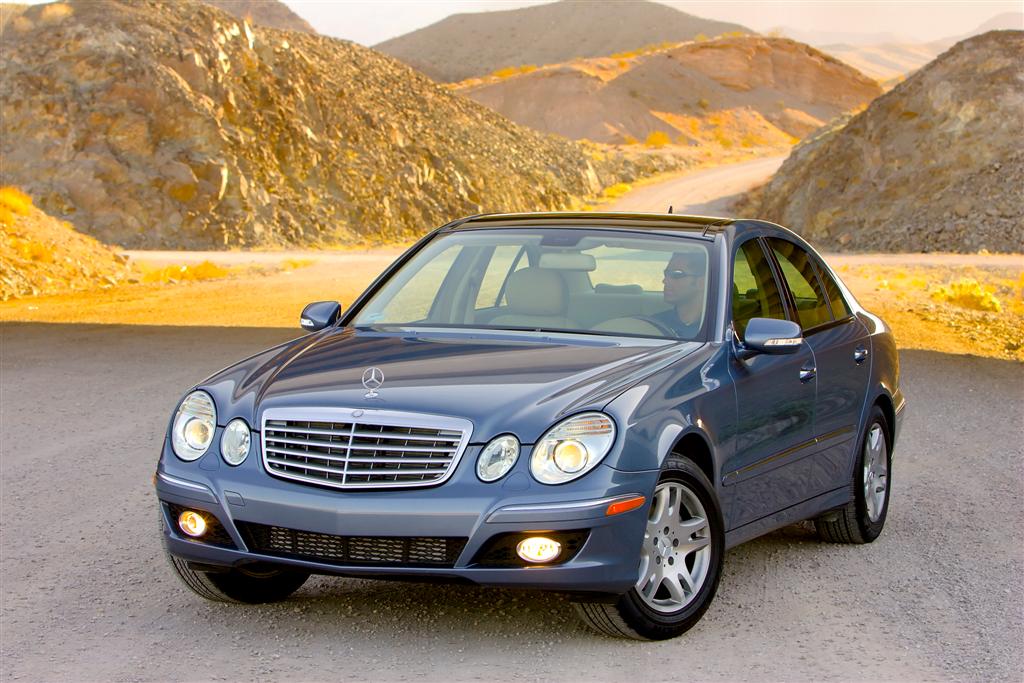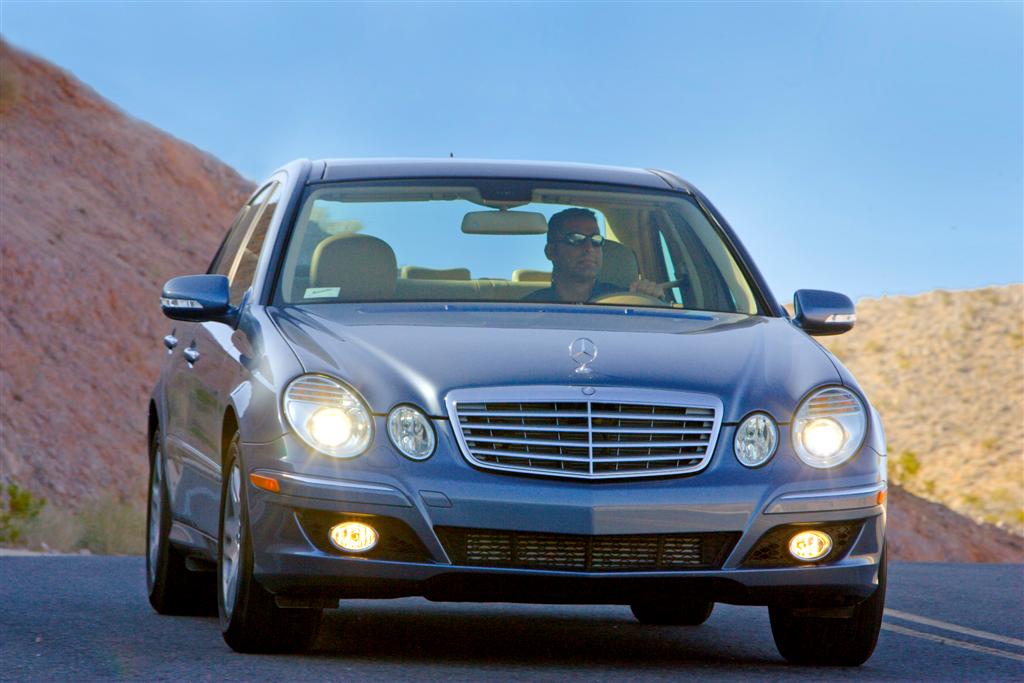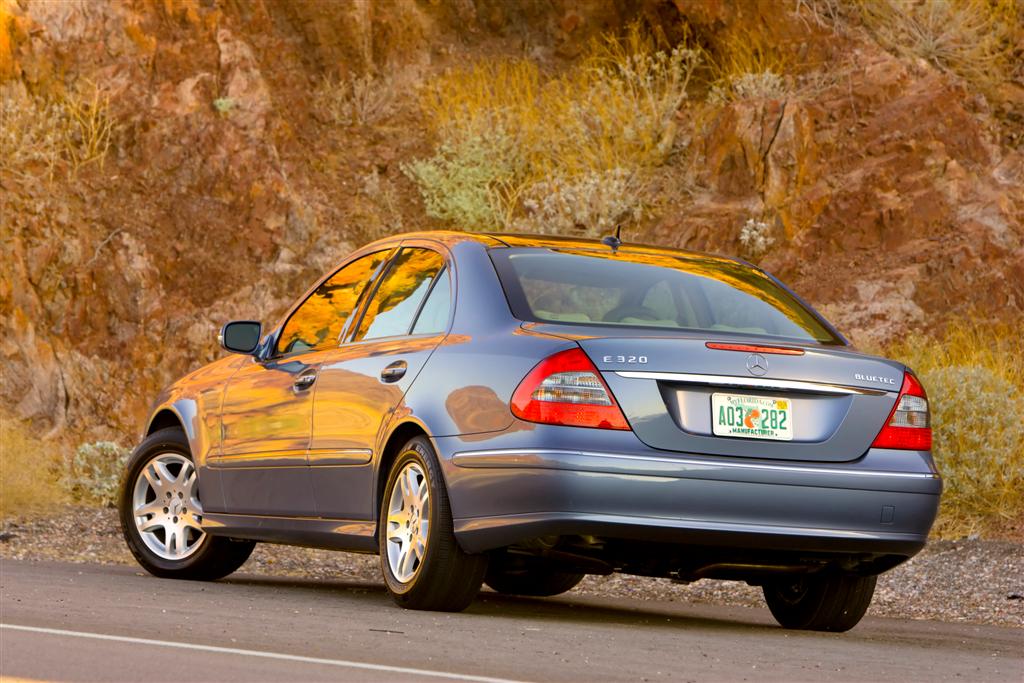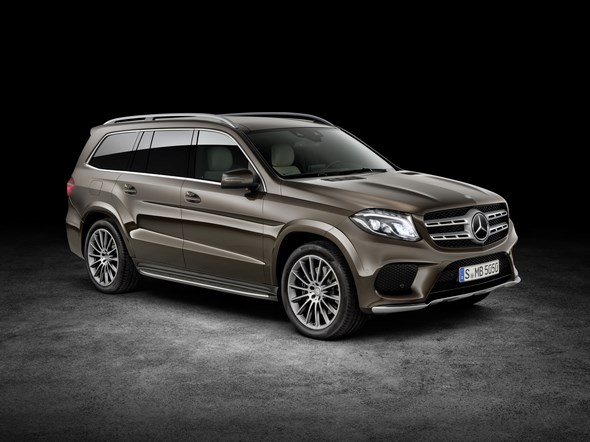E 320 BLUETEC

With the E 320 BLUETEC, Mercedes-Benz is launching a new era in diesel technology the USA

Stuttgart/Las Vegas, Spiralling fuel prices have also increased the demand for economical, clean cars in the USA. Mercedes-Benz is launching the new E 320 BLUETEC on October 15, timed to coincide with the introduction of low-sulphur diesel fuel in the USA. This model is also one of the most economical vehicles in its class and is regarded by experts as the pioneer of a new diesel era.
The introduction of clean diesel fuel in the USA represents an opportunity we have been battling for long and hard, the sort of opportunity we intend to utilise fully from day one, explained Dr Thomas Weber, head of Development at DaimlerChrysler AG and at the Mercedes Car Group, during the E 320 BLUETEC presentation in Las Vegas, Nevada. Background: state-of-the-art diesel vehicles, which already account for more than half of annual new registrations in Western Europe, have not yet realised their full potential in the USA due to excessive sulphur levels in existing fuel. All that is about to change with the nationwide introduction of clean diesel fuel with a sulphur content of just 15 ppm. Ultra Low Sulphur Diesel (ULSD) will be on sale at up to 76,000 US filling stations during the initial stage and will help promote the adoption of BLUETEC. This innovative diesel technology will also enable Mercedes-Benz to meet the world’s most stringent emission limits for nitrogen oxides, providing the right conditions for state-of-the art diesel technology to make its mark in the USA.
BLUETEC power is about to win many friends in North America as soon as US customers get behind the wheel of a car like the E 320 BLUETEC, says Dr Thomas Weber. Our 208 hp three-litre V6 develops eight-cylinder-like torque of 400 pounds feet (540 Nm) combined with the sort of economy you get from a four-cylinder engine in everyday use. The combined consumption of just 6.7 l/ 100 km (35 miles per US gallon) provides a range of 700 miles (around 1200 km) without having to refuel.
Ultra-modern diesel vehicles provide their owners with assured, clean and economical driving pleasure and can potentially given a sufficiently large uptake make national economies less dependent on oil imports. An EPA study dating back to 2004 confirmed the enormous potential savings inherent in diesel. Margo Oge, Director of the Office of Transportation and Air Quality, came up with the following calculation: if just a third of the light-duty vehicles in the USA were state-of-the-art diesel vehicles, we would be looking at saving 1.4 million barrels a day, the equivalent quantity of oil the USA imports from Saudi Arabia every day.
With no end in sight to soaring fuel prices, experts predict a greater uptake of diesel around the globe. The recent J.D. Power study Global Outlook For Diesel forecasts that the current global diesel market share of 18 percent is set to reach around 30 percent in 2015: diesel vehicles are expected to account for over 15 percent of new registrations in North America.
Additional BLUETEC models in the USA and Europe by 2008
Against this background, Mercedes-Benz intends to systematically broaden its BLUETEC portfolio. Dr Weber: In addition to the E 320 BLUETEC we aim to have another three BLUETEC models in the line-up as early as 2008 that meet the 50-state BIN 5 standard in the R-Class, ML-Class and the GL Class. Following its launch in the USA, Mercedes-Benz intends to successively roll out BLUETEC in other markets. At present the technology is being adapted to European market requirements and other Mercedes Benz models. The companys European customers should have the option of BLUETEC in a passenger car by 2008 at the very latest. Meanwhile the Jeep Grand Cherokee BLUETEC concept is a perfect example of how other DaimlerChrysler brands can also leverage BLUETEC.
BLUETEC is a modular emission control system that reduces nitrogen oxides. Diesel engine design means nitrogen oxide is currently the only emissions constituent that exceeds the equivalent figure for a petrol unit. Mercedes-Benz has developed BLUETEC in two versions: in the E-Class an oxidation-type catalytic converter and particulate filter are combined with an improved, extremely durable NOx trap system and an additional SCR catalytic converter. The second BLUETEC version is even more efficient. Here, AdBlue, a non-toxic aqueous solution, is injected into the exhaust-gas stream, causing ammonia to be released. In the downstream SCR catalytic converter the ammonia then converts up to 80 percent of the nitrogen oxides into the harmless natural products of nitrogen and water. The specific vehicle concept and weight as well as the deNOx requirements determine which BLUETEC system is used. In principle, BLUETEC is capable of meeting the worlds most stringent exhaust emission standards.The worlds cleanest diesel: First series-produced passenger car with BLUETEC from Mercedes-Benz
Advanced diesel technology represents a superior drive concept
High performance, extremely economical fuel consumption, long range and the lowest emissions ever
BLUETECs ability to meet even the most stringent emission limits means diesel technology is now ready for the future

BLUETEC technology is making Mercedes-Benz the pioneer of a new generation of clean and powerful high-tech drives, whose highly effective exhaust gas treatment systems give them the potential to fulfill the worlds most stringent emission limits in the future. At the same time, the basic technology for turbo-charging and common-rail direct injection used in Mercedes CDI diesel engines has already proved itself in millions of vehicles in Europe.
BLUETEC ensures that diesel drives will continue to offer outstanding driving pleasure in the future, especially in the U.S. Whats more, in view of continually rising fuel prices, BLUETEC represents a superior drive concept for both today and tomorrow.
The Mercedes-Benz E 320 BLUETEC offers outstanding driving dynamics and unprecedented efficiency and environmental compatibility. Its three-liter V6 engine combines the powerful torque of a high-volume V8 engine with the low fuel consumption of a compact model. The vehicle accelerates from 0 to 60 mph in just 6.6 seconds, making it one of the sportiest executive sedans on the market. Its tremendous torque of 400 lb-ft even exceeds that of most eight-cylinder engine models. At the same time, the Mercedes-Benz E 320 BLUETEC gets 35 miles per gallon (6.7 liters/100 km) in combined cycle driving. Thats a level of fuel efficiency normally found only in a compact car. The vehicle is also environmentally friendly through its excellent fuel economy and its extremely low emissions.
BLUETEC – a superior drive concept
The BLUETEC concept utilizes state-of-the-art diesel engines featuring common-rail direct injection, thereby providing all the benefits this drive system has to offer. Fuel consumption in these diesel vehicles is 20 to 40 percent lower than in cars equipped with a comparable gasoline engine, and torque – the key indicator of engine power – is 30 to 50 percent higher.
The E 320 BLUETEC offers an impressive example of such attributes: Its torque of 400 lb-ft gives it the power of a vehicle equipped with a high-volume V8 gasoline engine, and its acceleration from 0 to 60 mph in just 6.6 seconds is an illustration of the models outstanding performance. The vehicles top speed of 155 mph is, of course, a theoretical value in the U.S., but American customers are mainly interested in engines that deliver great power at low engine speeds, as this makes for confident yet relaxed driving, energetic acceleration, and long-range driving (up to 700 miles or more) on one tank of fuel. The E 320 BLUETEC definitely fulfills these requirements.
Moreover, its fuel economy ratings of 37 mpg (6.4 liters/100 km) in highway driving, and 26 mpg (9.0 liters/100 km) in the EPA city cycle, are higher than what many models in the compact class can offer. The BLUETEC system also performs well when matched up against hybrid technology, as the standard fuel economy ratings for the Mercedes E 320 BLUETEC are better than those for a hybrid of a comparable size and power output. The benefits offered by diesel engines often become more apparent in actual driving. Thats because diesel fuel consumption in real-life driving generally remains very close to fuel economy ratings, and is sometimes even better. This, however, is not the case with other drive systems. Diesels have in fact performed extremely well in comparative independent tests of diesel and hybrid vehicles conducted by journalists from automotive magazines on three different continents. In each case, whether driving straight across the U.S., Germany or Japan, the fuel consumption of diesel vehicles was significantly lower than that of hybrid cars.
The use of BLUETEC in the U.S. will be made possible by the introduction in that country of cleaner, low-sulfur diesel containing less than 15 ppm sulfur content. In line with corresponding legislation in the U.S. and Canada, the new fuel will become available all across the two countries in October 2006. The previous maximum sulfur content in diesel fuel was 500 ppm; sulfur content will therefore be reduced by a factor of 33, which will lead to an immediate noticeable reduction in emissions from all diesel vehicles. Thats because sulfur, which is present in varied concentrations in crude oil, is one of the key causes of particulate formation. Introduction of ULSD (Ultra Low Sulfur Diesel) has now made it possible to use particulate filters in the U.S. as well. Whats more, this fuel will enable efficient aftertreatment of nitrogen oxide emissions. The fuel supply for the worlds cleanest diesel has therefore now been secured, especially as the Mercedes E 320 BLUETECs ability to travel more than 700 miles (approx. 1,200 km) on one tank of fuel means its drivers wont have to go looking for gas stations very often.
Rather than being an isolated solution, the E 320 BLUETEC is just one part of DaimlerChryslers overall strategy of ensuring sustainable mobility for the future. The 3.0-liter diesel engine in the E 320 BLUETEC is used by the Mercedes-Benz brand in ten of its model series. The BLUETEC technology will be initially launched in the U.S., after which Mercedes-Benz will prepare for its introduction to other markets. BLUETEC will also be made available in a passenger car model in Europe beginning in 2008. DaimlerChrysler does not plan to restrict the use of BLUETEC to the Mercedes-Benz brand alone: The Jeep Grand Cherokee BLUETEC concept car, for example, represents one additional application possibility for the future.
BLUETEC – the market
Mercedes-Benz is considered to be the pioneer of diesel technology: The Mercedes-Benz 260 D, which was presented 70 years ago, was the worlds first series-produced diesel passenger car. Over the years, Mercedes-Benz has consistently employed its innovative strength and engineering talent to enhance and improve the internal combustion system invented by Rudolf Diesel.
Mercedes also has a great diesel tradition in the U.S. that stretches back more than 40 years. The most successful diesel phase to date for the brand was during the 1980s, when diesel passenger cars accounted for up to 80 percent of total Mercedes-Benz sales in the U.S. As a result, Mercedes-Benz not only has a longer history of diesel expertise than any other automaker, but also understands the U.S. diesel market better than anyone else. Back in August 2002, during a time when it appeared that diesel passenger cars had practically no future in the U.S., Mercedes-Benz laid the cornerstone for a new era of diesel success by introducing the E-Class 211 series.
Then, in January 2004, the brand officially launched diesels U.S. comeback at the Detroit Auto Show with the E320 CDI, which went on sale in April 2004. State-of-the-art common-rail direct injection, high injection pressure, and a turbocharger with variable turbine geometry made the E320 CDI much stronger, quieter and cleaner than any diesel that had ever come before it. Sales of the E 320 CDI have risen sharply since oil prices jumped for the first time in August 2005, and more than 11,000 E-Class vehicles with a diesel drive have been sold in the U.S. since the market launch in April 2004.
Market analysts agree that diesel vehicles will continue to become more popular. Automotive Industry Data, for example, predicts that diesel vehicles will account for nearly 60 percent of passenger cars in Western Europe in 2009, while J.D. Power expects the diesel share of western European passenger cars to rise to around 56 percent over the medium term.
Diesel market shares around the world are fundamentally influenced by fuel prices. The more expensive fuel becomes, the higher the market share for fuel-efficient diesels. Fuel prices have traditionally been lower in the U.S. than elsewhere in the world, and this in part explains why diesels share of vehicle registrations in the U.S. is still comparatively low. Another explanation is offered by the fact that no sulfur-free fuel has been available up until now, and such fuel is indispensable for state-of-the-art diesel technology.

Few have noticed that sales of passenger cars and light trucks equipped with diesel engines have risen 40 percent in the U.S. over the last five years – perhaps because the sales volume was rather low to begin with. Still, more than 550,000 diesel passenger cars and light trucks were sold in the U.S. in 2005, an increase of nine percent from the prior year. The market share for diesels in the U.S. reached 3.5 percent in 2005, which was more than the hybrid market share of 1.2 percent. The share of sales of light trucks – which make up nearly half the U.S. vehicle market – accounted for by diesel vehicles was almost six percent last year.
Forecasts regarding the diesel share of the U.S. market in the future are optimistic. An extensive study conducted by J.D. Power, for example, predicts that the market share of diesel vehicles in the U.S. will increase from 3.5 percent in 2005 to more than 15 percent in 2015. Automotive Industry Data also forecasts that diesel vehicles will account for more than 15 percent of the market in the U.S. over the long term.
This will be very important for the U.S. because diesel vehicles can offer huge fuel savings potential if their market share is extrapolated to the entire market. This was confirmed in a study conducted by the U.S. Environmental Protection Agency in 2004. Margo Oge, head of the Office of Transportation and Air Quality, concluded in the study that if only one-third of all light-duty trucks in the U.S. were operated with modern diesel engines, the country would save 1.4 million barrels of oil per day in the U.S. the amount of oil the U.S. currently imports from Saudi Arabia.
Fuel price developments, and – more importantly – the huge improvements made to the performance and comfort offered by modern diesel engines, have led to a tremendous increase in the market share for diesel vehicles in Europe over the past few years. Whereas diesel vehicles accounted for 32 percent of new registrations in western Europe in 2000, that figure had risen to 49.5 percent by 2005, meaning that nearly half of all new automobiles in the region are now equipped with a diesel drive system. The diesel share for SUVs is between 80 and 100 percent around the world, and upper-range vehicles such as the Mercedes-Benz E-Class represent another segment in which diesels perform well.
BLUETEC – a modular technology
BLUETEC is a modular concept that utilizes various coordinated technical measures that both minimize engine-out emissions within the engine and also provide for effective exhaust gas treatment downstream. The process involves gradually but consistently reducing all relevant emission components to a minimum. The system for passenger cars includes an oxidizing catalytic converter and a particulate filter in addition to effective techniques for reducing nitrogen oxide emissions. BLUETEC technology is particularly important for lowering nitrogen oxide emissions, which are the final component of exhaust gas and are higher in diesel vehicles than in cars equipped with gasoline engines due to the diesels principle of operation. Up until recently, the only real remaining disadvantage of diesel engines as compared to gasoline engines was in the area of specific emissions, especially of particulates and nitrogen oxides. However, Mercedes-Benz set the standard for modern diesel drive systems in the fall of 2003, when it introduced the maintenance-free particulate filter in combination with the EU4 emission. The brand is still not letting up here, despite having achieved an approximately 75 percent reduction in emissions through engine-internal measures over the past 15 years. The mission is clear: Through the use of innovative BLUETEC technology, diesel engines from Mercedes-Benz have the potential to comply with the worlds most stringent emission standards. When this has been achieved, Mercedes-Benz will be able to offer the worlds cleanest diesels in every vehicle class.
The key aspect of the innovative BLUETEC technology involves lowering levels of nitrogen oxides (denoxification) in an effective and economical manner. In order to combine all technical solutions for emission reduction into an optimized package, Mercedes-Benz is implementing a multi-staged plan consisting of the following measures:
Optimization of engines and combustion processes in order to reduce engine-out emissions as much as possible. This includes the use of electronic engine control systems, four-valve technology, third-generation common-rail direct injection with piezo injectors, variable-geometry turbochargers and exhaust gas recirculation.
Use of oxidizing catalytic converters to minimize emissions of carbon monoxide (CO) and unburned hydrocarbons (HC).
Use of the particulate filter, which has been standard equipment in all Mercedes-Benz diesel passenger cars in many countries since the summer of 2005, cuts particulate emissions by up to 98%. This filter has led to particulate emissions significantly lower than the current EU4 limit of 0.025 grams/kilometer. Currently valid emission standards in the U.S. are thus also being met.
The diesel principle makes concentrations of nitrogen oxides higher in diesel engine-out emissions than in those of gasoline engines. However, nitrogen oxides are reduced to such an extent by BLUETEC as to enable compliance with the most stringent exhaust gas limits worldwide in the future.
The E 320 BLUETEC uses a refined NOx storage catalytic converter in combination with an SCR catalytic converter to lower nitrogen oxide emissions.
In future models, BLUETEC will be used in conjunction with the even more effective method of AdBlue injection, which involves the application of the selective catalytic reduction (SCR) technique. This is currently the most effective method for exhaust gas treatment, enabling nitrogen oxide emissions to be reduced by up to 80 percent. The combination with AdBlue is currently being developed for series production and will be used primarily in large vehicles and SUVs. The Mercedes Vision GL 320 BLUETEC concept car, for example, is currently the worlds cleanest and most fuel efficient SUV in its class. Regardless of the vehicles in which it is used, the technology enables compliance with the worlds most stringent emission limits, including the BIN 5 norm that will go into effect in the U.S. in 2009.
The SCR process involves adding the reducing agent AdBlue to the exhaust flow. AdBlue is an aqueous carbamide solution that is stored in an extra tank. Because only around 0.1 liters of AdBlue is needed on average for every 100 kilometers driven (the equivalent of one to three percent of diesel consumption), its tank can be designed in such a way that it only needs to be refilled during regular maintenance checks. Injecting AdBlue into the exhaust gas releases ammonia (NH3), which causes the reduction of nitrogen oxides into harmless nitrogen and water in the downstream SCR catalytic converter. Achieving the high efficiency here requires adding precisely the amount of AdBlue needed for the respective particular engine operating state.
BLUETEC technology has been used successfully in more than 25,000 commercial vehicles from Mercedes-Benz since 2005. In fact, BLUETEC has decreased nitrogen oxide emissions to such an extent that the trucks in question already produce lower emissions than required by the new limits set to go into effect in 2009. Euro 5 trucks are also entitled to pay reduced road tolls in Germany up until 2009. Three thousand locations in Europe now offer AdBlue.

DaimlerChrysler decided at an early stage to use SCR-based BLUETEC technology to meet the Euro 4 and Euro 5 limits for commercial vehicles, and also to employ it as a basis for meeting even more stringent European emissions standards in the future. All European manufacturers have since followed suit and are now developing technologies based on SCR to ensure compliance with Euro 5.
The challenge for the future: Sustainable mobility
Fossil fuels are a finite resource, which is why ensuring sustainable mobility is the most important challenge for the future. The situation is made more urgent by the fact that the consumption of energy is rising around the globe, which means the amount of carbon dioxide released into the atmosphere is also increasing. It is therefore clear that automobile manufacturers must strive to reduce the consumption of fossil fuels and the emissions they produce, and also develop alternatives for the future. A large share of the 5.6 billion DaimlerChrysler spends each year on research and development goes toward achieving this goal.
At the same time, the company is convinced that this goal can only be achieved through an integrated approach that addresses mobility as a complete system – one which begins with the vehicle but also includes fuels and transport infrastructure.
The fact is that consumption and emissions can only be further reduced in combination with optimized fuels. Cleaner fuels can already be used today in existing fleets to help significantly lower emissions. The current focus is on promoting the global introduction of low-sulfur fuels in order enable the development of cleaner and more economical drive systems.
Biogenic fuels represents the dawn of a system of mobility practically free of CO2 emissions. When burned, such fuels generate only as much carbon dioxide as the plants used to make them absorbed from the air. Biodiesel, which is made from vegetable oils, offers advantages over diesel from petroleum with regard to combustion. The same is true of bioethanol, which is made from wheat, corn, or sugar cane. So-called Flex-Fuel vehicles, which can be operated with an 85-percent bioethanol-gasoline mix, are now playing an important role in the U.S., and DaimlerChrysler already has 1.5 million such vehicles on the road.
Biomass-to-liquid fuels (BTL), such as SunDiesel, have the best prospects for future success, however – and DaimlerChrysler has been working extensively on the development and production of such fuels for years now. A partnership between DaimlerChrysler, Volkswagen, CHOREN and Shell is now developing and testing SunDiesel in vehicles in Germany. The fuel is made from scrap wood, but actually any kind of biomass can be used to produce it. The ecological balance shows that the use of SunDiesel leads to emissions approximately 90 percent lower than those produced by conventional fuels. Tests conducted by DaimlerChrysler have also confirmed the fuels excellent quality, and plans now call for filling new diesel passenger cars with SunDiesel at the factory as soon as the fuel becomes available in sufficient quantities.
DaimlerChryslers commitment to clean drive systems and to renewable, environmentally friendly fuels is an element of the Groups strategy for the future. The aim here is to achieve sustainable mobility. Doing so will involve addressing three dimensions – the economy, the environment and society. The latest Sustainability Report provides a closer look at DaimlerChryslers research and development activities and at the links between environmental protection, social responsibility and economic prosperity.





